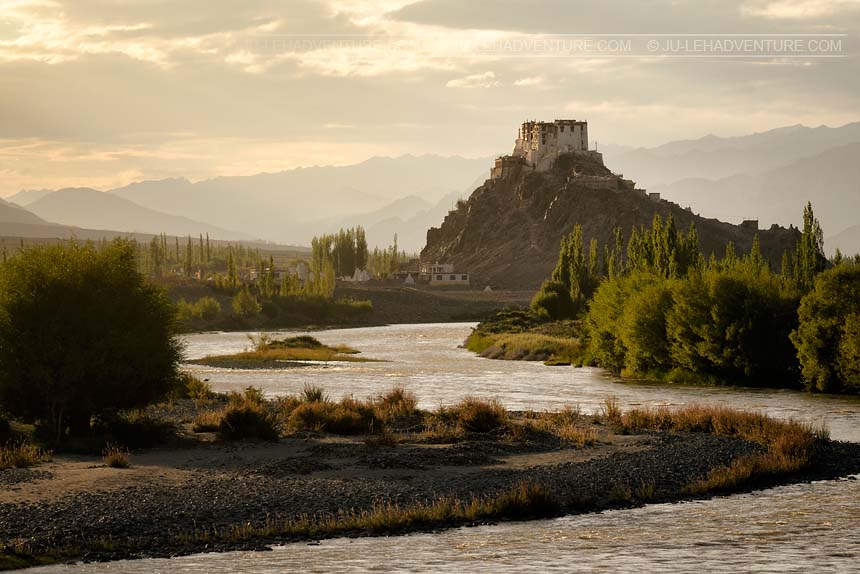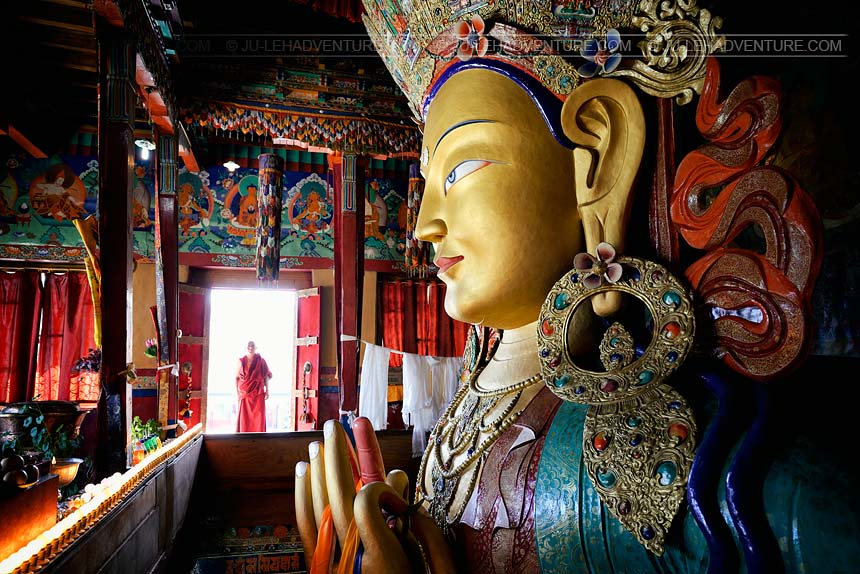10 amazing Buddhist Monasteries to visit in Ladakh
Ladakh being a Buddhist-dominated area, religion plays a promiment role in the lives of the people of Leh and Ladakh. Bright colourful prayer flags, whitewashed stupas, the smell of juniper wafting through the air, monks adorned in red robes and elderly people circumambulating monasteries and stupas are a common sight in Ladakh.
It is also hardly surprising to see monasteries in every village and settlements in Ladakh. Monasteries or gompas (meaning “solitary places” in Ladakhi) epitomise the glory of Buddhism in the region, especially in Leh district. Gompas are centers of worship, and the monks or lamas perform their duties as per the ancient established routine oblivious of the worldly matters around them. Monasteries are often built on a hill slope overlooking the village or the town. If not for the stupas (chorten in Ladakhi), mani walls (long walls with prayers carved on the stones) and multi-coloured prayer flags fluttering on the top of the buildings, monasteries are often mistaken for forts due to their massive walls, imposing buildings and the secluded spot on which they are built. Some gompas in Ladakh dating back to the 11th century continue to stand tall and hint strongly at its former glory.
Though Ladakh has a large number of monasteries worth mentioning, we look at ten of the most popular monasteries in the region.
1. Hemis Monastery
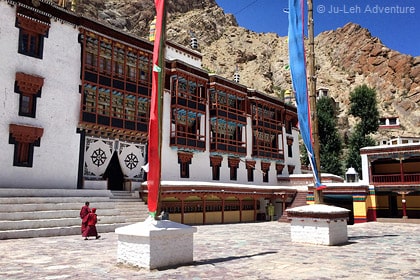
Nestled in the mountains hidden from the main road, Hemis monastery is the spiritual center of the Drukpa lineage or the 'Red Hat sect'. Hemis gompa is famed for being the largest and richest monastery in Ladakh. It was founded in the 1630s by Stag Tsang Raspa under the royal patronage of King Singge Namgyal.
Hemis monastery is located at a distance of 40 km from Leh town. Thousands of tourists from all over the world assemble at the monastery to celebrate Hemis Tsechu (Tsechu means the tenth day on which the annual monastery festival is carried out) which is dedicated to Padmasambhava or Guru Rinpoche. The three-centuries old silk thangka painting of Guru Rinpoche is only unfurled every 12 years. Also, the Naro Gyantuk (six bone ornaments of Naropa) is put on public display that attracts thousands of Buddhists from all parts of the world to visit Hemis to seek its blessings.
Hemis monastery also has a museum with centuries-old statues and thangkas of Buddhist gods and goddesses. Tourists can purchase curios, paintings and postcards, wooden statues and other artifacts from the museum shop. Tourists can also visit the Naropa Photang (Palace in Ladakhi) on the way to Hemis gompa.
2. Alchi Monastery
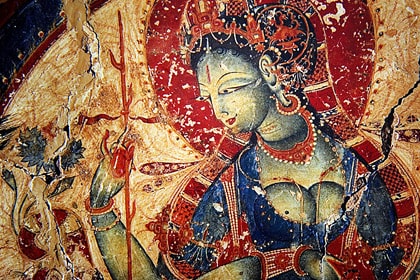
Considered as one of the oldest monasteries in Ladakh, Alchi gompa was founded in the 11th century by Rinchen Zangpo, the famous translator from Tibet. It is said that Rinchen carried willow sticks with him and planted them at different places in Ladakh and Zanskar. It is said that these sticks turned green and monasteries were constructed at these places. Legend also goes that Rinchen Zangpo finished the construction of the gompas at Alchi, Mangyu and Sumda overnight. Rinchen Zangpo enrolled Kashmiri artists for the wall paintings and carvings at the monastery and therefore it is easy to differentiate between the wall paintings at Alchi, Mangyu and Sumda and other monasteries in Ladakh. The paintings on walls of the Alchi monastery are among the world’s masterpieces of art and religion. Unlike other monasteries in Ladakh, which are constructed on a hill, the gompa at Alchi is on flat ground.
3. Phuktal Monastery

Although Zanskar has been traditionally known as ‘land of religion’, monasteries are fewer in number than the central Ladakh. What it lacks in number, it makes up for it with its antique and impressive structures of the gompas. Reaching Phuktal monastery is challenging as it can be reached only on foot. However, it is a photographer’s delight as the gompa is built on a cliff and the principal shrine rooms are constructed inside a cave. There is an intricate network of wooden ladders and platforms that the monks and visitors use to reach the gompa. Even though there is little record of Phuktal monastery’s foundation and history, some paintings at the gompa are identical in style with those at Alchi. Phuktal was a important religious center in Zanskar. A part of the Phuktal gompa was damaged by heavy snow in 2010.
4. Thiksey Monastery
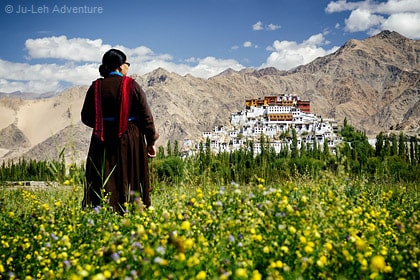
Thiksey monastery stands out for its sheer size and grandeur. Located 19 km east of Leh town, Thiksey gompa has striking resemblance to Potala Palace in Lhasa, Tibet. Thiksey monastery was established during the period of Gelugpa expansion in the 15th century. It is one of the largest monasteries in Ladakh, with buildings on a cliff rising in tier upon tier dominating and complementing the village.
The monastery houses a 15-meter-high statue of Maitreya Buddha or Future Buddha (known as Chamba in Ladakhi) in a two-storeyed shrine room. The Buddha statue was dedicated by His Holiness the Dalai Lama in 1980. Since Thiksey is famous for the statue of the Maitreya Buddha (Chamba), which is one of the largest in Ladakh, newborns are often christened Chamba by the Rinpoche (spiritual and religious teacher).
The roof-terrace of the gompa offers a stunning view of the Stok Kangri peak, Stakna and Matho gompa, Shey palace and green lush fields. Tourists can attend the early morning puja (prayer) at the monastery.
5. Lamayuru Monastery
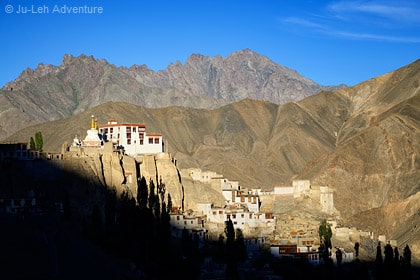
Lamayuru monastery is one of the most picturesque gompas in Ladakh. Perched on a mountain above the valley off the main road descending from Fotu La pass to Khalse, Lamayuru gompa is believed to be the oldest monastery in central Ladakh. Lamayuru, which is at a distance of 115 km from Leh, is on the Leh-Srinagar national highway.
The main assembly hall (dukhang) is built around the opening of a cave in which Naropa (teacher of Marpa who later taught Milarepa - one of Tibet's most famous yogis and spiritual poets) rested and meditated in the 11th century. The legend goes that the area was the bottom of a deep lake. Over time, the sands of this former lake have turned to form landscapes resembling a moonland.
6. Karsha Monastery
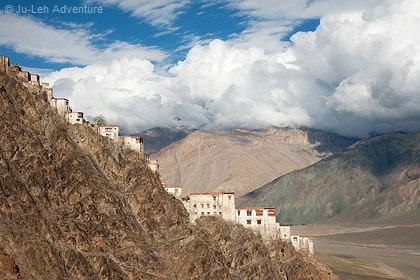
Karsha gompa is easily distinguishable as it is the largest Buddhist monastery in Zanskar. The monastery that dates back to the 10th century is situated on a mountainside above the central plain. As whitewashed village houses are built on the slope beneath it, the monastery is visible for miles. The foundation of the gompa is attributed to Padmasambhava or Guru Rinpoche whereas the wall paintings also link it to Rinchen Zangpo, the famous translator from Tibet. Some of the shrine rooms were repaired in the ’90s. The old-fashioned whitewashed homes and barley fields can be seen from the roof of the gompa.
7. Diskit Monastery
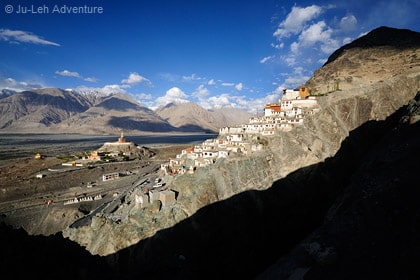
If you have not been already mesmerised by the beautiful Nubra valley, then the majestic Diskit monastery surely will. Diskit, the administrative center of Nubra valley, is known for its monastery which is the largest and oldest gompa in the valley.
Founded by Changzen Tserab Zangpo in the 14th century, Diskit gompa is famous for its 32-meter-high statue of Maitreya Buddha that was inaugurated by His Holiness the Dalai Lama in 2010. Tourists can enjoy the wonderful panoramic view of the Nubra valley from the base of the statue of Maitreya Buddha.
Dosmochey festival is celebrated at Diskit monastery, where people from different villages in the Nubra valley assemble to watch the monks perform mask dance or cham.
8. Likir Monastery

Likir, located 60 km west of Leh town, can be reached by a motorable track. Likir gompa is said to have been founded in the 11th century and was associated with the Kadam-pa order. The monastery was extended during 15th century. However, the present structure of the gompa was built in the 18th century as the earlier structure was destroyed by fire.
The 23-meter-tall statue of Maitreya Buddha that is visible from a distance is the unique feature of the monastery. The gilded statue was consecrated in 1997 and sits next to the gompa’s main building.
9. Namgyal Tsemo Gompa
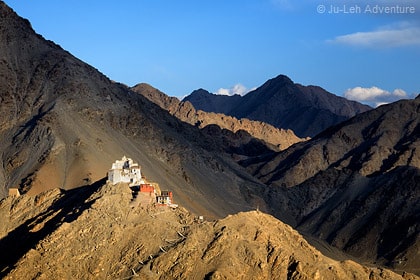
Overlooking the Leh town, Namgyal Tsemo is recorded as the first royal residence of Leh. Although a small building, Namgyal Tsemo has a towering presence that demands attention. According to legendary tales, Tashi Namgyal, a king from the Namgyal dynasty that ruled Ladakh for almost four centuries, defeated the Mongol army and buried the corpses beneath the feet of the images of Srungma (or guardian deities).
The deserted complex comprises the gon-khang (room of guardian deities) and the fort of Tashi Namgyal. The gon-khang houses the six-armed Mahakala whose phallus is worshipped by women for the favour of a child. The gompa also enshrines a 8-meter-high statue of Maitreya Buddha.
However, with time, Tashi Namgyal’s fort is now lying in ruins and can be reached by climbing the dilapidated steps and broken walls. Namgyal Tsemo offers a magnificent view of Leh town, Zanskar range and peak of Stok Kangri.
10. Basgo Monastery
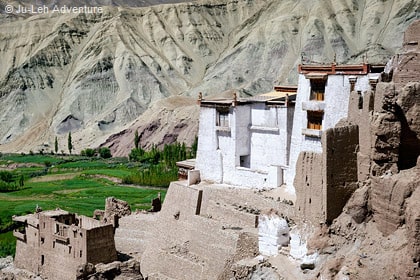
Basgo was the capital of lower Ladakh in old times and it is mentioned as the capital of Ladakh in some of the books published by European travellers. Basgo was one of the royal residences along with Leh and Shey. The gompa at Basgo was built by Tsewang Namgyal and is the only monastery in Ladakh with murals surviving from the 16th century.
According to historians, the invasion of Tibetan and Mongol armies was checked in the 17th century at Basgo. The ruined forts and buildings share tales of the strength of the palace against the siege it withstood for three years.
Restoration work was started at the monastery by the local community with the help of NIRLAC in the '90s. Later, UNESCO and the World Monument Fund also extended support and the restoration work won the UNESCO Asia-Pacific Heritage Award of Excellence in 2007.
When to visit these Buddhist monasteries?
Hemis monastery and Thiksey monastery can be visited during the 1-day Indus valley tour to Hemis. They can also be visited on the way to Pangong lake or Tso Moriri lake.
Alchi monastery, Lamayuru monastery, Likir monastery and Basgo monastery are included in the 2 or 3-day Indus valley tour to Lamayuru.
You can visit Phuktal monastery and Karsha monastery during the Zanskar valley tour.
The Diskit monastery is one of the highlights of the Nubra valley tour.
You will have the chance to visit Namgyal Tsemo gompa during your stay in Leh.

 Hemis to Tso Moriri
Hemis to Tso Moriri
